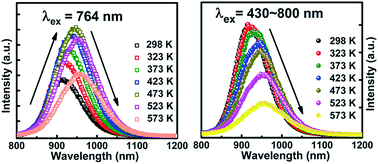Temperature-dependent near-infrared emission of highly concentrated Cu2+ in CaCuSi4O10 phosphor
Abstract
CaCuSi4O10 (CCS4O) shows a 430–800 nm broad excitation band and an intense 918 nm near-infrared (NIR) emission peak at room temperature (RT). The electronic structure calculated by density functional theory (DFT) is discussed in an attempt to understand the small quenching effects in this highly concentrated Cu2+ material, which may be ascribed to the localization of 3d electrons of Cu2+ ion and weak interaction between Cu2+ ions. The assignments of photoluminescence excitation (PLE) and photoluminescence (PL) peaks are made based on the absorption spectrum and crystal field theory. In particular, we investigate the temperature-dependent PL spectra upon excitation by monochromatic light and simulated sunlight. The distinct variation in PL intensities with temperature upon the two means of excitation can be understood by configurational coordinate (CC) models, in which different thermal activation energies are considered. Furthermore, Ba2+-doped and Zn2+-doped series are used to illustrate the relation between the redshift of the PL peak and lattice expansion. The high thermal quenching temperature (555 K) and low concentration quenching (unchanged lifetimes when diluting Cu2+ ions) indicate that this phosphor has great potential as an inorganic dye for luminescent solar concentrator (LSC).


 Please wait while we load your content...
Please wait while we load your content...